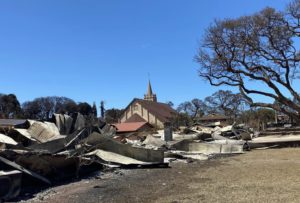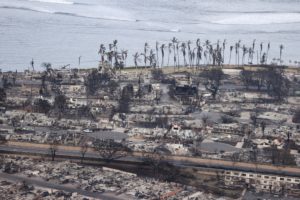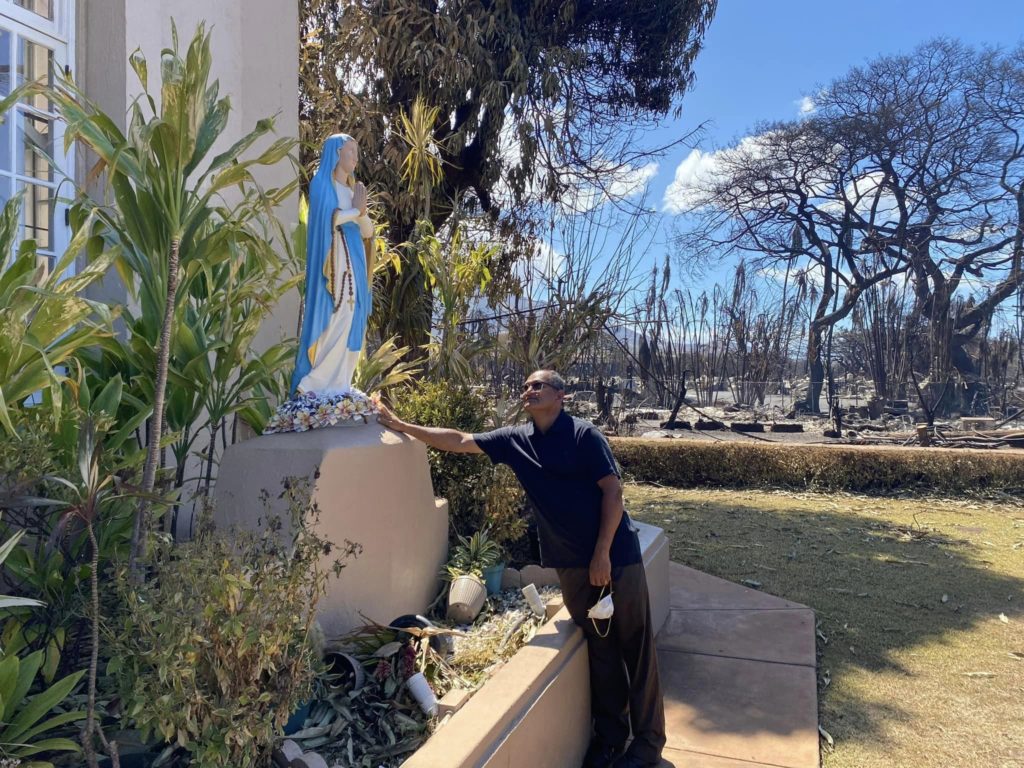At dawn on Tuesday, Aug. 8, Hurricane Dora churned 600 miles off Hawaii, but its winds had already torn a solar panel off the roof of Sacred Hearts School at historic Maria Lanakila Parish in Lahaina Town on Maui. Principal Tonata Ah Lolesio sent her maintenance man husband up a ladder to attempt repairs, but he was nearly blown over.
As she and the pastor, Father Kuriakose Nadooparambil, discussed the options, they saw a utility pole down in front of the church. School was canceled.
By dusk, the school building was in ruins.
The town had been immolated by wind-whipped wildfires that incinerated at least 2,000 homes and businesses. So far 115 bodies have been found and about 380 people remain missing. At Maria Lanakila, the school was half gone, the convent and parish hall destroyed. But the church, founded in 1846 and later served by St. Damien of Molokai, was untouched.
Some have called it a miracle, and there were more to come.
Around 4 p.m. a sister called Lolesio to say that the priests and parish staff were evacuating to Maria Lanakila’s mission church in Kapalua, also called Sacred Hearts. Lolesio expected to meet them in a few minutes. Instead, she worried and prayed for two hours, before they arrived with a harrowing story of barely escaping the flames after stopping to pick up fleeing residents.
Some of Lolesio’s faculty and staff had lost homes, but they quickly began checking on all 220 students — without modern communications.
“I’m sure you can imagine how much anxiety that caused. We were just praying that all the kids would come back as accounted for and safe,” she said.
They were. It was another miracle.
However, about 120 students have been displaced to other parts of the island, state, and nation. Joining about 100 returning students will be 125 newcomers whose public school burned down. Plans are in the works to subsidize tuition for those who lost homes and jobs.
School resumed Aug. 28, initially at Sacred Hearts mission church, and eventually at an office park that the diocese will lease and renovate into classrooms. Because Maria Lanakila is in a condemned zone, Lolesio does not expect to teach there again for years.
The students “are moving from hotel to hotel, from family home to family home,” she said. “We want to be able to provide some sense of stability.”
They will bring a few grades back at a time, starting with the youngest. A childhood trauma specialist will have each child “adopt” a weighted teddy bear, in which they will be encouraged to confide their thoughts and anxieties.
Visible proof of a miracle?
About 25 miles away, on Aug. 8 Msgr. Terrence Watanabe had thought his biggest challenge that day would be the roof damage at Sacred Hearts School. The wind was calm on his side of the island.
Then news channels erupted with reports of wildfires consuming Lahaina. Watanabe, the vicar forane for Maui’s 10 parishes and pastor of St. Anthony of Padua in Wailuku, began to pray hard.
“We asked God to be with those people. We couldn’t run in there to help because of the fires,” he said.
For days he was unable to reach the pastor and staff of Maria Lanakila. Phone lines and cell towers were ash and molten metal. He didn’t know if the priests, sisters, and lay staff were alive.

Eventually the pastor called from a hilltop with a weak cell signal. He obtained a police escort to inspect Maria Lanakila, whose name means Our Lady of Victory.
What the priests found awed them.
The convent, parish hall, and most of the school were destroyed, the trees in the cemetery next to the church charred and withered. But the church wasn’t even smoke-stained.
The interior walls and mosaic of St. Damien were pristine. Days after the inferno, flowers gracing the altar, statues, and an image of Divine Mercy appeared fresh-picked.
“The Church of Maria Lanakila stands as a sign of hope. It wasn’t singed or scorched,” Watanabe said. It “was completely surrounded by fire, so the heat must have been incredible. But the grass was still green in front of the church.”
Now, the priest is helping Catholic Charities of Hawaii erect 350 miniature “palette homes” on church property for relief workers and displaced residents.
Each unit holds just two sets of bunk beds. Shower and laundry facilities will be in separate portable buildings. A donor in Oregon offered them to Catholic Charities and the Matson shipping company will deliver them for free, Watanabe said. Catholic Charities is also sending trauma counselors.
As survivors emerge from the initial shock, “we’re starting to see some call for spiritual support,” he said.
A long road to healing
Catholicism on Maui has a remarkable history. The first Catholic priests to arrive in Hawaii in 1827 were persecuted and forced off the islands four years later. Hundreds of Hawaiian Catholics were imprisoned. But lay catechists on Maui were such powerful evangelizers that the priests who returned in 1846 found 4,000 converts eager for baptism.
Today, Catholicism is the largest religious body in Hawaii. Its traditions have been enriched by waves of immigrants from Portugal, Puerto Rico, and the Philippines. Many homes destroyed in Lahaina belonged to first-generation Filipino immigrants.
On Aug. 8, Angela Baraquio Grey, the Hawaiian daughter of Filipino immigrants who became the first Asian Miss America in 2001, was preparing for the first day of school at St. Anthony of Padua in Gardena, where she is the principal. Her son sent a news story about the fires, then her social media blew up.
A high school friend in Lahaina was begging for prayers. Her uncle was missing, and would later be found dead.
“So it wasn’t just an article anymore. It was something very close to home,” Grey said.
Despite her losses, her friend was raising money to help her neighbors.

Days later she watched a video of her friend walking through the apocalypse of her neighborhood. She passed scorched skeletons of trees, cars with melted tires, cinderblock pillars marking the graves of houses. A metal bed frame or seared refrigerator might be the only discernible belongings. Birds chirped incongruously in the background.
Grey, who has maintained a speaking platform on character education and pro-life issues, is using her media presence to help where she can.
“I would ask first and foremost for prayers and the offering of Mass for the repose of the souls of those who perished,” she said.
She asks people to carefully choose reputable charities that will deliver their gifts to the survivors. And she castigated some callous real estate developers.
“It’s shocking,” she said. “People are trying to figure out where their loved ones are and how they are going to live and eat and drink on this day, and they are getting calls saying, ‘Do you want to sell your land?’ That is an extremely insensitive way to treat grieving people.”
Her school is committed to helping, but will take time to choose the right relief project.
“It will be a long road to healing for the victims, and we just need to spread love and aloha at this time,” she said.
Hawaiians helping each other out
On Maui the pulse of helicopters no longer signals sight-seeing flyovers, but supply drops. Boats haul emergency supplies close to a beachfront park, where volunteers riding Sea-Doos or rowing dinghies unload them, said Father Ken Deasy, a retired priest of the Archdiocese of Los Angeles who shares a house with friends about two miles outside the disaster zone.
“I’ve been picking up supplies because I have a truck,” he said.
“The response is Catholic in every sense of the word. I’m not sure it’s very Roman, but it’s very universal. Everyone is helping one another out.”
He visited the makeshift morgue, with about 100 bodies. “I went just to provide a little comfort to those who are grieving and waiting outside to find out if the ones they are missing are in the morgue. It’s very slow going — it will take a long time to find out,” he said.

Another LA priest, Father Preston Passos, pastor of St. Mary Magdalen Church in Camarillo, had gone home to Honolulu for his 50th birthday — Aug. 8. None of his relatives on Maui were directly affected, although they are out of work.
His home parish of St. Augustine Church by the Sea in Waikiki sprang into action with prayer and relief work. It is a sister parish of Maria Lanakila, since both are churches of the Congregation of the Sacred Hearts of Jesus and Mary, the first priests to evangelize in Hawaii.
Hawaiian Catholics are calling on Sts. Damien and Marianne Cope, who cared for lepers on the island of Molokai.
“Right now there is definitely a sense of closeness to them, and interest in asking for their intercession. But, as a people here in the islands there’s a very spiritual connection to each other, a devotion to helping people, regardless of what faith that they follow,” Passos said.
On the Sunday after the fires, Bishop Larry Silva of the Diocese of Honolulu celebrated Mass at the mission church of Sacred Hearts. Few knew of his coming, but 200 were at 8 a.m. Mass.
They came “because they were just happy to be with one another, to support one another, to hear each other’s stories,” Watanabe said. The bishop “was there to pray with them and console them.”
He thought that the bishop’s homily said what people needed to hear.
“He spoke about how important it is for us to continue trusting God, who promises to be with us in good times and the bad,” Watanabe said. “At the same time,” he said, “we shouldn’t be giving God the silent treatment. If you’re angry with him, it’s OK. Because God can handle it. The worst thing would be for us not to talk to God during these times. He will continue to give us the strength and courage that we need to work through this.”
Learn more about how you can help Maui here.

